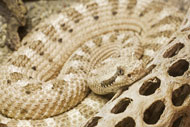Description:
Widely known because of the erect scales over its eyes and distinctive sidewinding movement across loose sand, this little rattlesnake can be difficult to adapt to the terrarium. Wild-caught specimens are notorious for heavy parasite loads and must be wormed by a qualified veterinarian and checked for other types of parasites. Additionally, they are subject to blister disease due to humidity in the terrarium. A 20-gallon terrarium with excellent ventilation works well. The substrate should be dry sand or anything similar that will not hold moisture. Give a small bowl of water once every two or three weeks—the snakes get their water from their food and don’t normally drink, but a spill can cause serious problems. The temperature should be maintained between 80 and 90 degrees Fahrenheit, with an undertank heating pad and a basking lamp. Feeding is often a problem. In nature the sidewinder takes a variety of lizards and small rodents, but in the terrarium it often demands lizards. Mediterranean geckos (Hemidactylus turcicus) have proven acceptable and easy to obtain; they should be fed after being frozen and thawed to reduce infectious parasites. Sidewinders often can be tricked into taking small mice by placing a baby gecko or a gecko tail in the mouth of the mouse. Though not considered deadly, the bite of this species is dangerous and damaging and it also is a speedy snake, so precautions should be taken at all times.
Habitat:
Because of its sidewinding movements, this rattlesnake typically occupies open areas such as flat expanses of loose sand, sand dunes and low hillsides with a mix of sand and gravel. It almost always is found near the burrows of its rodent prey.
Range:
Found from southeastern California barely into Utah and south to southwestern Arizona and northwestern Mexico.
Scientific Name: Crotalus cerastes
Species Group: venomous
Family: Viperidae
Size: 20 to 30 inches
Level: advanced
Weight:
Dangerous: No



